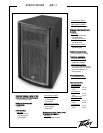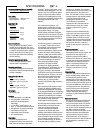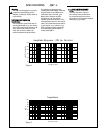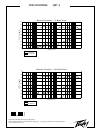
SPECIFICATIONS QW
™
-2
CCrroossssoovveerr ffrreeqquueennccyy ((iinntteerrnnaall ppaassssiivvee))::
L
ow frequency - high frequency:
1,200 Hz
TTiimmee ooffffsseett::
Low frequency: delay 0.27 ms
High frequency: 0.00 ms
IImmppeeddaannccee ((ZZ))::
F
ull range:
Nominal: 8.0 Ω
Minimum: 6.2 Ω
L
ow frequency:
Nominal: 8.0 Ω
Minimum: 6.5 Ω
High fr
equency:
Nominal: 8.0 Ω
Minimum: 7.1 Ω
IInnppuutt ccoonnnneeccttiioonnss::
Two 4-pin Neutrik
®
Speakon
®
jacks in
parallel for full-range input. One 4-pin
switching Neutrik Speakon jack features
a normal 4-pin Speakon jack in parallel
with the driver side for bi-amp inputs.
The second jack allows daisy chaining
when bi-amping.
EEnncclloossuurree mmaatteerriiaallss aanndd ffiinniisshh::
0.720 in. plywood finished in black
Hammer Head
™
Polyurethane
MMoouunnttiinngg pprroovviissiioonnss::
This unit is not designed for overhead
suspension; however, an optional flying
version is available.
DDiimmeennssiioonnss ((HH xx WW xx DD))::
F
ront:
33.38" x 21.13" x 22.59"
848 mm x 537 mm x 574 mm
R
ear:
33.38" x 13.78" x 22.59"
848 mm x 350 mm x 574 mm
NNeett wweeiigghhtt::
98 lbs. (44.5 kg)
FFeeaattuurreess
• 1,600 W program, 3,200 W peak
• Very low power compression
• Quadratic Throat Waveguide
™
technology
• 15" Pro Rider
™
woofer with 4" VC
• 44XT
™
4" titanium compression driver
• SoundGuard
™
44 tweeter protection
• Low distortion at high SPL
• Trapezoidal enclosure design
• SA-1 stand adaptor
DDeessccrriippttiioonn
The latest high performance
loudspeaker system from Peavey, the
QW-
™
2 has the new extra-high power
Pro Rider
™
woofer incorporated, a new
Quadratic Throat Waveguide
™
horn, as
well as a very nice looking new cabinet
design. Its trapezoidal shape reduces
the build-up of standing waves inside
the enclosure, minimizing mid-bass and
mid-range colorations due to the
cabinet.
It is constructed of premium .720"
plywood and is covered with a tough,
durable black textured Hammer Head
™
polyurethane coating. A 16 gauge
powder-coated perforated metal grille
covers the front of the system to protect
the speakers from external damage. An
SA-1 stand mount adaptor is built-in for
ease of speaker stand use.
The two-way system is comprised of a
15" Pro Rider
™
woofer with a Kevlar
®
impregnated, water-resistant treated
cone and dust cap for superior
environmental stability. Capable of over
600W of continuous power handling
(AES Std 2-1984), the Pro Rider woofer
can handle a lot of sheer power. The
high frequencies are handled by a 44XT
™
4" titanium diaphragm compression
driver, utilizing ferrofluid cooling,
coupled to a CH 942qt constant
directivity horn utilizing Quadratic
Throat Waveguide
™
technology. The CH
942qt is protected under US Patent
6,059,069, and due to this patented
geometry, the horn has lower distortion
than many popular CD horns. The 44XT
driver features the Radialinear Planar
Phase Correction System, under US
Patent 6,064,745, which provides
smoother and extended high frequency
response.
Input connection to the system is made
via two 4-pin Neutrik in parallel, and a
4-pin Neutrik switching jack is provided
for bi-amping flexibility while maintaining
superior signal integrity. The inclusion of
a standard 4-pin Neutrik jack in parallel
on the driver side of the bi-amp switching
jack provides for daisy chaining to
another cabinet when bi-amping.
The internal passive crossover features
Sound Guard 44 tweeter protection
circuit and an advanced topology
crossover with high performance
components to provide high power
handling and reliability. Peavey’s Sound
Guard high-frequency driver protection
circuitry provides long and medium term
driver overload protection when the
system is used full-range, or when it is
bi-amped, without impairing musical
transients or dynamics. The crossover
provides driver roll-off and protection, as
well as driver EQ for the woofer and
horn. The sum total is a clean, clear and
smooth response. High-quality, reliable
crossover components include
polypropylene capacitors, and high
current inductors. The optimal
integration of the crossover with the
selected drivers results in a smooth
frequency response from 52 Hz to
18 kHz.
Despite its compact dimensions, this
system puts out some serious sound
levels. A 1,600 Watts program of clean
amplified power can result in precise
coverage with excellent clarity and high
reliability. Very low power compression
and very low distortion combine to
provide a clean, dynamic, yet punchy
sound.
FFrreeqquueennccyy rreessppoonnssee
This measurement is useful in
determining how accurately a given unit
reproduces an input signal. The
frequency response of the QW-2 is
measured at a distance of 1-meter using
a 1 Watt (into the nominal impedance)
swept-sine input signal. As shown in
Figure 1, the selected drivers in the
QW-2 combine to give a smooth
frequency response from 52 Hz to
18 kHz.
PPoowweerr hhaannddlliinngg
There are many different approaches to
power handling ratings. Peavey rates
this loudspeaker system’s power
handling using a full-range form of the
AES Standard 2-1984. Using audio band
20 Hz to 20 kHz pink noise with peaks of
four times the RMS level, this strenuous
test signal assures the user that every
portion of this system can withstand
today’s high technology music. This
rating is contingent upon having a
minimum of 3 dB of amplifier headroom
available.
HHaarrmmoonniicc ddiissttoorrttiioonn
Second and third harmonic distortions
vs. frequency are plotted in Figures 3
and 4 for two power levels. Ten percent
(10%) of rated input power and either
one percent (1%) of rated input power or
one Watt, whichever is greater.
Distortion is read from the graph as the
difference between the fundamental
signal (frequency response) and the
desired harmonic. As an example, a
distortion curve that is down 40 dB from
the fundamental is equivalent to 1%
distortion.






